
The Atari Jaguar is a home video game console developed by Atari Corporation and released in North America in November 1993. Part of the fifth generation of video game consoles, it competed with the 16-bit Sega Genesis, the Super NES and the 32-bit 3DO Interactive Multiplayer that launched the same year. Powered by two custom 32-bit processors – Tom and Jerry – in addition to a Motorola 68000, Atari marketed it as the world's first 64-bit game system, emphasizing its 64-bit bus used by the blitter. The Jaguar launched with Cybermorph as the pack-in game, which received divisive reviews. The system's library ultimately comprised only 50 licensed games.

Magic Carpet is a 3D flying video game developed by Bullfrog Productions and published by Electronic Arts in 1994. Its graphics and gameplay were considered innovative and technically impressive at the time of its release.
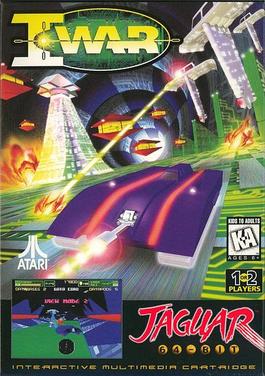
I-War is a 1995 shooter video game developed by Imagitec Design and published by Atari Corporation for the Atari Jaguar. The plot takes place in a futuristic setting where the mainframe supercomputer Override begins to mutate databases and create computer viruses. The player is tasked with piloting an antivirus tank vehicle to eliminate mutated databases and viruses clogging the I-Way network, while recovering data pods and facing off against a variety of enemies.
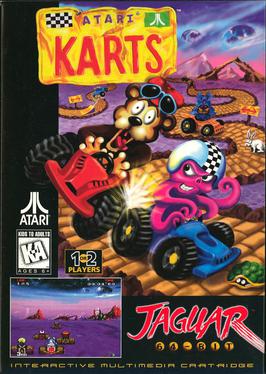
Atari Karts is a kart racing video game developed by Miracle Designs and published by Atari Corporation for the Atari Jaguar in North America on December 22, 1995, and Europe on January 1996. In the game, the players take control of one of several playable characters, each with differing capabilities. One or two players race against computer-controlled characters in four cups consisting of multiple tracks over four difficulty levels. During races, the players can obtain power-ups placed at predetermined points in the tracks and use them to gain an advantage. It plays similarly to Super Mario Kart and features Bentley Bear, main protagonist of the arcade game Crystal Castles (1983).

White Men Can't Jump is a 1995 basketball video game developed by High Voltage Software (HVS) and published by Atari for the Atari Jaguar. It is loosely based on the 1992 20th Century Fox film of the same name. The game features a loose version of basketball known as streetball. It can be played against computer-controlled opponents, or up to four human competitors using the Team Tap multitap.

The Need for Speed is a 1994 racing game developed by EA Canada, originally known as Pioneer Productions, and published by Electronic Arts for 3DO in 1994. It allows driving eight licensed sports cars in three point-to-point tracks either with or without a computer opponent. Checkpoints, traffic vehicles, and police pursuits appear in the races.
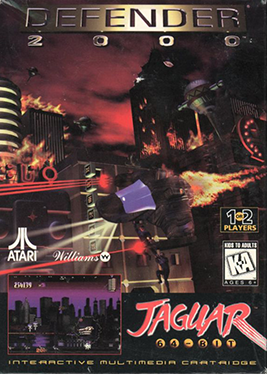
Defender 2000 is a 1996 scrolling shooter video game developed by Llamasoft and published by Atari Corporation for the Atari Jaguar. Part of Atari's 2000 series of arcade game revivals, it is an update of Eugene Jarvis' arcade game Defender (1981). The premise takes place in a future where the Alpha Promixian empire attack mining settlements on distant resource planets. Gameplay is divided into three modes, with the player acting as part of the System Defense Team commanding the Threshold ship to defeat waves of invading aliens while protecting humans.
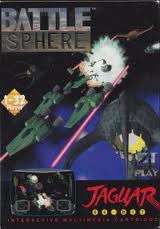
BattleSphere is a space combat simulation video game developed by 4Play for the Atari Jaguar. The game was released in 2000, with the enhanced edition BattleSphere Gold released in 2002. Set during a future war between seven alien races, the factions agree to confine their hostilities to a tournament with the galaxy at stake. Gameplay consists of five modes, each featuring distinct scenarios and objectives. Up to 16 players can participate in a deathmatch mode via local area network (LAN) play.

T-MEK is a two-player, sit-down, virtual reality fighting arcade game developed and published by Atari Games in 1994.
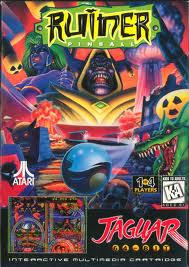
Ruiner Pinball is a 1995 pinball video game developed by High Voltage Software (HVS) and published by Atari Corporation for the Atari Jaguar. The game features two different pinball tables: the nuclear war-inspired Ruiner, and the medieval-themed Tower. Each table contains targets for the player to hit with the ball, increasing their score before the ball is lost. It was marketed as the first title to support the ProController, a redesigned Jaguar controller that added three more face buttons and two triggers.

Baldies is a 1995 real-time strategy video game developed by Creative Edge Software and originally published by Atari Corporation for the Atari Jaguar CD. It was later ported to the PC, PlayStation, Sega Saturn, and Macintosh. In the game, the player manages a community of Baldies in order to build structures, increase their population, and create weapons to fight against enemies known as Hairies. There are four classes of Baldies and each structure has specific properties to assist the player. Its gameplay combines strategy with simulation and god game elements. Up to four players can participate in a multiplayer mode via local area network (LAN) on PC.

Battlemorph is a 1995 shooter video game developed by Attention to Detail (ATD) and published by Atari Corporation for the Atari Jaguar CD. It is the sequel to Cybermorph (1993), a pack-in game for the Atari Jaguar. Taking place 30 years after the events of the original game, the player pilots the morphing infiltration fighter War Griffon in an extermination mission against the Pernitia empire, which plans to launch a full-scale invasion to eradicate humanity and take over the galaxy after being pushed back to their home planet. The player is tasked with various objectives, while fighting against enemies and bosses, across eight galaxy clusters in order to liberate them from control of the empire.

Club Drive is a 1994 racing simulation video game developed and published by Atari Corporation for the Atari Jaguar. The premise takes place in 2098 at the Club Drive amusement park, where driving became legalized after being deemed illegal for safety reasons years prior due to the invention of indestructible vehicles which allowed the ban to be lifted. Gameplay consists of three modes for one or two players, each with their own adjustable ruleset.
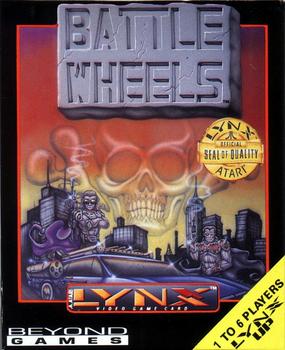
BattleWheels is a 1993 first-person vehicular combat video game developed by Beyond Games and published by Atari Corporation in North America and Europe exclusively for the Atari Lynx. The first project to be created by Beyond Games, the game takes place in a dystopian future where civilization has been reduced to a Mad Max-inspired landscape and players take the wheel of heavily armed and armored cars called Hi-Tech in order to compete against either computer-controlled opponents or other human players using the Lynx's ComLynx system in matches set across multiple post-apocalyptic locations.

Missile Command 3D is a 1995 shoot 'em up video game developed by Virtuality Entertainment and published for the Atari Jaguar. As part of Atari's 2000 series of arcade game revivals, it is an update of Dave Theurer's arcade game Missile Command (1980). The game has the player defend six cities from incoming missiles by launching anti-ballistic missiles.
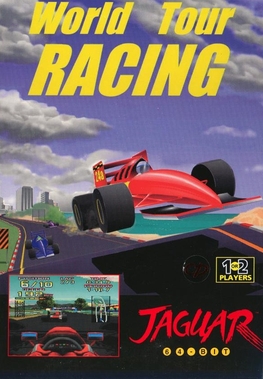
World Tour Racing is a 1997 racing video game developed by Teque London and published by Telegames for the Atari Jaguar CD. In the game, the player controls a Formula One car competing against computer-controlled opponents in races across multiple locations. Gameplay consists of three modes and the player can customize the vehicle's characteristics.

Power Drive Rally is a 1995 racing video game developed by Rage Software and published by Time Warner Interactive for the Atari Jaguar. It is a conversion of the 1994 racing game Power Drive, which was released on multiple platforms. Revolving around rallying, the game features six real vehicles and circuits based on eight locations around the world. The players participate in various racing events and earn money by qualifying or winning to continue the rally season and repair damage to the car.
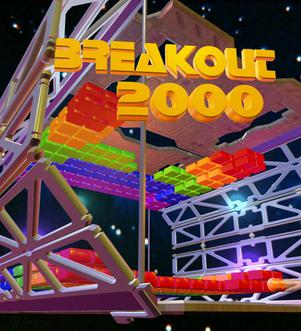
Breakout 2000 is a 1996 action video game developed by MP Games and published by Telegames for the Atari Jaguar. Part of the 2000 series by Atari Corporation, it is a remake of the arcade game Breakout (1976), and one of the last officially licensed releases for the platform. Featuring a similar premise to Breakout, the player must destroy a layer of brick lines by repeatedly bouncing a ball spawned off a paddle into them and keep it in play. Gameplay modifications to the original game include a third-person perspective behind the paddle in a pseudo-3D playfield, power-ups, bonus levels, enemies, varying level designs, and multiplayer features.

Checkered Flag is a 1994 racing video game developed by Rebellion Developments and published by Atari Corporation for the Atari Jaguar. It is a conversion of the 1991 Atari Lynx title of the same name. In the game, the player controls a Formula One car competing against computer-controlled opponents in races across multiple locations. Gameplay consists of three modes, and the player can choose various weather conditions or customize the vehicle's characteristics.
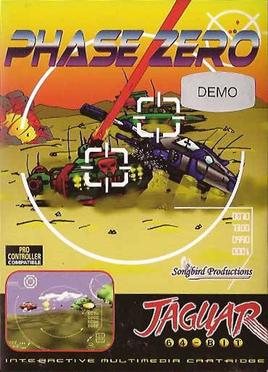
Phase Zero is an unfinished shooter video game that was being developed by Hyper Image Productions and would have been published by Atari for the Atari Jaguar. Set in the future on a terrestrial planet, the player takes on the role of a newcomer to the Phase Zero squad, piloting a hovercraft to fight rival corporate states. The player is tasked with various objectives while fighting enemies in multiple missions.





















